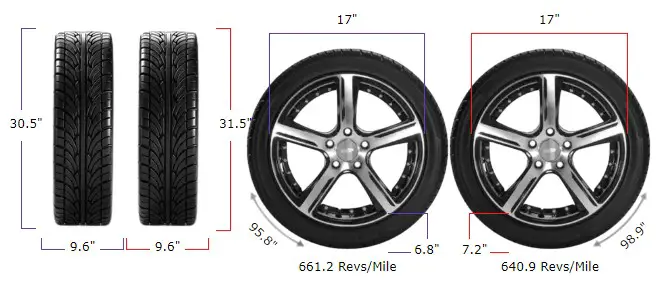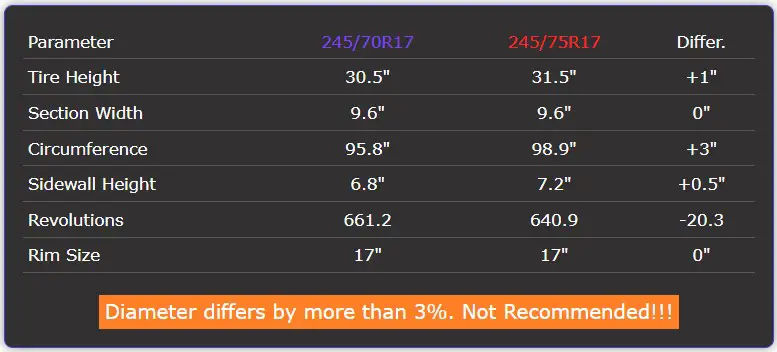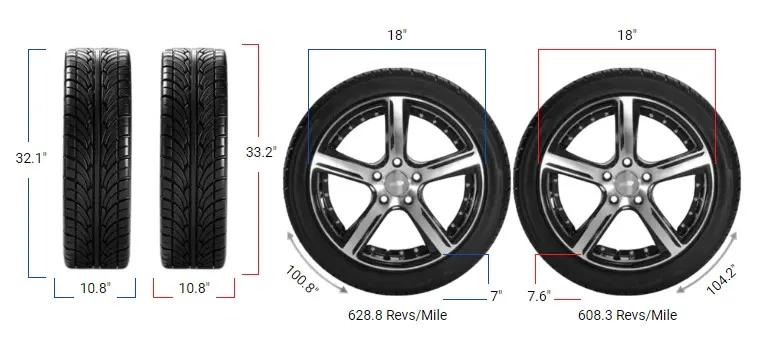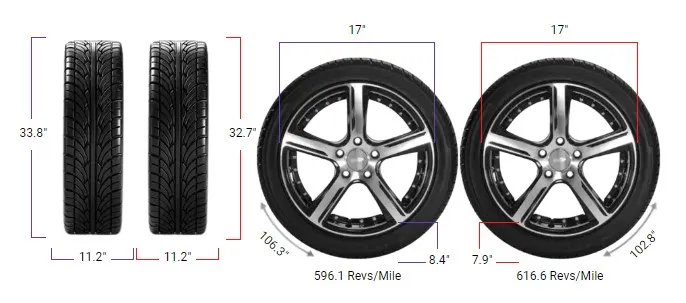Tire Size 245/70r17 vs 245/75r17

Thinking about upgrading your tires? Switching from 245/70r17 to 245/75r17 may seem straightforward, but it’s important to understand how it affects your vehicle.
- The 245/75R17 provides a larger diameter for improved ground clearance.
- A taller sidewall height enhances comfort on rough roads.
- The increased circumference may improve stability during highway driving.
- Fuel efficiency might decrease due to the larger tire size.
- The same width maintains consistent handling characteristics.
- The taller tire can enhance off-road capability and traction.

Fitment Guide
According to the Fitment Guide, replacement tires should be within 3% of the original diameter. The 245/75r17 exceeds this limit by 0.2%, reaching 3.2%.
Therefore, the interchange is not recommended without necessary adaptations to prevent issues like rubbing or clearance problems.
On-Road Impact
Switching tire sizes can significantly affect your vehicle’s behavior on paved roads. Here’s how the change impacts on-road performance.

- Ground Clearance: The larger diameter increases ground clearance by about 0.48 inches (12.25 mm). This helps you navigate speed bumps and rough roads more easily.
- Gas Mileage: Slightly larger tires can cause your engine to work harder, potentially leading to a minor decrease in fuel efficiency.
- Aesthetic Look: Taller tires give your vehicle a more rugged appearance, which some drivers find appealing.
- Ride Comfort: The increased sidewall height (a 7.1% increase) provides more cushioning, possibly improving ride comfort over bumps and potholes.
- Speedometer Accuracy: With the larger tire circumference, your speedometer will read lower than your actual speed. When it shows 20 mph, you’re actually traveling at 20.63 mph.
- Durability & Wear: The new tire size may have different wear characteristics, potentially affecting tire longevity.
Off-Road Impact
The tire change also affects how your vehicle performs off the beaten path. Here’s what to expect when off-roading with the new size.

- Ground Clearance: Increased ground clearance aids in navigating obstacles like rocks and logs, enhancing off-road capability.
- Traction: The same tire width means traction remains similar, but the larger diameter helps roll over uneven terrain more effectively.
- Clearance Issues: Exceeding the recommended diameter limit may cause the tires to rub against wheel wells or suspension components during extreme articulation.
- Vehicle Stress: Larger tires can put additional stress on suspension and drivetrain components, possibly requiring upgrades for optimal performance.
245/70r17 vs 245/75r17
This table compares the key features of tire sizes 245/70R17 and 245/75R17.
| Feature | 245/70R17 | 245/75R17 | Difference |
|---|---|---|---|
| Diameter inches (mm) | 30.5 (774.8) | 31.47 (799.3) | 0.96 (24.5) 3.2% |
| Width inches (mm) | 9.65 (245) | 9.65 (245) | 0 (0) 0% |
| Circumference inches (mm) | 95.83 (2434.11) | 98.86 (2511.08) | 3.03 (76.97) 3.2% |
| Sidewall Height inches (mm) | 6.75 (171.5) | 7.23 (183.75) | 0.48 (12.25) 7.1% |
| Revolutions per mile (km) | 661.16 (410.83) | 640.9 (398.24) | -20.27 (-12.59) -3.1% |
| Speedo Reading | 20 mph (32.19 km/h) | 20.63 mph (33.2 km/h) | +0.63 mph |
Difference Between 245/70R17 and 245/75R17
The main difference is diameter; the 245/75R17 tire is 0.96 inches (24.5 mm) taller than the 245/70R17 tire, affecting ride height and speedometer accuracy.
Can I Use 245/75R17 Instead of 245/70R17?
It’s not recommended, as the 245/75R17 tire is 3.2% larger in diameter, exceeding the advised maximum difference of 3%. This may impact handling, braking, and speedometer readings.
How Much Taller Is a 245/75R17 Tire Than a 245/70R17?
The 245/75R17 tire is 0.96 inches (24.5 mm) taller than the 245/70R17 tire, a 3.2% increase in overall diameter.
Our Observation
Switching from 245/70r17 to 245/75r17 offers both advantages and drawbacks. The increased diameter provides slightly higher ground clearance, which is beneficial for off-road driving and overcoming obstacles.
The taller sidewall may improve ride comfort by absorbing more road vibrations. However, the 3.2% increase in diameter exceeds the recommended limit, potentially causing speedometer inaccuracies and minor changes in handling dynamics.
On-road, the effects are generally minimal and may go unnoticed by many drivers. The speedometer reading will be off by about 3%, showing 20 mph when you’re actually going 20.63 mph.
Off-road, the benefits of extra clearance are more pronounced, but the risk of rubbing or clearance issues increases without proper adjustments.
It’s essential to consider these factors and possibly consult a professional before making the switch. Overall, the differences are modest but should be carefully weighed before making the change.



